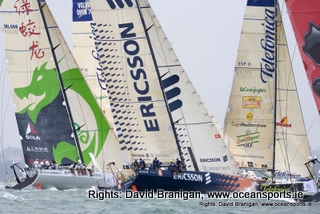 Recently new rules were unveiled related to the next edition of the Volvo Ocean Race. Against a background of an economic backdrop and ever rising team budgets seen during the last few editions, Volvo Ocean Race CEO Knut Frostad and team have done a remarkable job; without having compromised the spirit and objectives of the Volvo Ocean Race, they have created rules that should be acceptable to all main user groups. And contrary to what one would expect in such an environment, the end result is clear and well formulated and has not become a “consensus monstrosity” as we have lately seen in for example Formula 1. As a result the race should get cheaper and more competitive, possibly resulting in a higher number of entries.
Recently new rules were unveiled related to the next edition of the Volvo Ocean Race. Against a background of an economic backdrop and ever rising team budgets seen during the last few editions, Volvo Ocean Race CEO Knut Frostad and team have done a remarkable job; without having compromised the spirit and objectives of the Volvo Ocean Race, they have created rules that should be acceptable to all main user groups. And contrary to what one would expect in such an environment, the end result is clear and well formulated and has not become a “consensus monstrosity” as we have lately seen in for example Formula 1. As a result the race should get cheaper and more competitive, possibly resulting in a higher number of entries.
Let us first examine the main new rules.
– Boats: the rules limit the number of sails (New pre-race sails limited to 15 for one boat entered the race. Race sails reduced from 24 to 17 per boat) used and the construction of one single boat for each team. A team is permitted to campaign one second generation and one third generation boat. Additionally rules are set related to weight, keel, bulb, mast (a maximum of 2), stacking and testing are set.
– Testing and crew; No two-boat testing before the race is allowed. The number of crew allowed will remain at 11 for each of the VO70 yachts, including a media crew member. However, a female team can comprise a crew of 14. Three crew members to be born on or after 1st September, 1980. An increase of one from 2008-09. No additional crew for port races is allowed
– In-port races and points system: there will be an in-port race in every stopover with no additional crew allowed. Simultaneously the points system will be revised. points for offshore legs will now be multiplied by five, and scoring gates multiplied by two. The in-port races will not attract a weighting and points will continue to be awarded for the best performances over two races to be held on each in-port race day.
– The race will be shorter than the last one
So what were the reasons behind the new rules? What were the main problems the Volvo Ocean Race organisation was confronted with? The main one could be found in mounting costs for the teams. As a result of ever rising budgets it had become more and more expensive to participate in the Volvo Ocean Race, severely limiting the number of entries. In the last race only 8 teams started the race, whilst one of them had to quit because of funding. A second related problem could be found in the wide variety of team budgets (from approx. EUR 10mln for Delta Lloyd to close to EUR 90m for Ericcson), which theoretically should benefit the richer teams; for example the richer teams could pay for a first generation boat, whilst the “poorer” teams” use second generation boats. Given both this background and the economic crisis, it would be questionable whether there would be sufficient interest in the 2011/12 edition of the race. Hence the neccessity for drastic action is explained.
So in such an environment what would (similar to Formula 1) have been easier than just proposing a budget cap? Praise should go to the organisation to not go for this escape route, which would have led to all kind of problems; think of how to police and administer a cap and the many grey areas which are open to interpretation and open to competitors taking advantages out of the regulations, again think Formula 1. Rather than choosing this negative approach, the organisation has come up with a much more positive strategic and lateral solution. By introducing rules that limit what it takes to win the race, it makes winning it more achievable and entry into the race more attractive to a larger number of teams as well as to the sponsors. In fact the organisation has turned the picture around, first working out what is required to win the race and control these elements. Therefore the incentives in terms of performance gains for spending lots of money has been reduced, which could lead to significant cost reduction. Teams can still pay excessive amounts (if they want )but incremental benefits are likely to be much smaller and hence competition should be more tight.
What were the organisation’s key objectives when drafting these Volvo Open 70 Rules and have they been met? And the user groups, should they be happy? Lets first look at the objectives of the organisation:
A. Reduce costs for participating teams. Clearly these rules should lead to significant savings; it is no longer allowed to build more than one boat for a campaign, two boat testing is no longer allowed, the number of sails allowed has been significantly reduced, personnel expenses for the teams should come down and shared services for the teams may be introduced. By containing these costs, it is now believed that somewhere around the 20m Euro-mark is a winning budget. Some teams will do the race well for 15m Euros and for others it will be 25m Euros.
B. To ensure improved safety and reliability of the boats: under the new rules everything has to meet the safety test. The new rules are strict. The biggest message that came back from the designers and sailors was ‘don’t change too much’. The boat is fast and it is strong. The furling headsails introduced are aimed at keeping crew off the foredeck as much as possible, note the foredeck is the biggest danger area.
C. To ensure that the Volvo Open 70 Class maintains its status as the fastest and most spectacular offshore racing monohull. As Ken Reed of Puma phrases it well; theules eliminate the need to have a huge budget teams but it doesn’t do it so radically that this isn’t still the grand prix of sail boat racing right now. Moreover high budgets are still allowed, which still should leave room for R&D, the difference being that the incremental benefits are likely to be smaller
D. To ensure that an entrant can be competitive with a second generation boat from the 2008-09 race. The changes are designed to produce closer racing between the existing and future fleets of Volvo Open 70s and discourage the expensive research and long, slow builds that result in maximized bulb weights (strict limits are set related to bulbweights). The advantages enjoyed by the most powerfully-backed entries have been narrowed and hence the expectations for the lower budget teams should improve
Looking at the user groups, we believe there is little reason for complaints. Sponsors should be happy as their ROI should be significantly higher. Not only should the initial investment be smaller, the returns could turn out substantially higher than before. By having a higher number of entries and by having closer racing, competition should increase and the attraction of the event should become bigger.Sailors and teams should also be happy. The Rules have been designed in close cooperation with the teams and a lot of attention has been paid to safety and the complaints during the last race. The new rules should ensure there is a next race and hence most of the sailors assured from a decent job. The media and audience should also benefit. Closer racing with more boats and leveraging through the new media should lead to more spectacular racing. Finally the race organisation itself should be happy as with these rules, the future of their existence should be guaranteed for at least a few more editions.
In my opinion these rules are an excellent piece of lateral thinking. Frostad and team have been able to come up with a solution which should guarantee the sustainability of the race for both the short and long term without compromising either the spirit or the objectives of the race. That is a great step for the race, great for the sailors and sponsors, and most important it will ultimately improve the contest Having done the race himself a few times, Frostad knows as nobody else what is in a sailors mind and has safeguarded their interest and safety. It again shows sports organisations are often best managed by the people that have been actively involved in the sports. Frostad seems to be well on his way to win yet another race.
 One of golf’s most famous and celebrated holes in the world, the 17th St Andrews hole, the Road Hole, will be lengthened by 35 yards, to 490 yards. Work will begin this week and a new tee will be built on a driving range nearby.
One of golf’s most famous and celebrated holes in the world, the 17th St Andrews hole, the Road Hole, will be lengthened by 35 yards, to 490 yards. Work will begin this week and a new tee will be built on a driving range nearby.